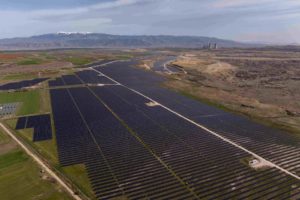Bucharest’s new office hot spots

Bucharest office market landscape is changing, as new clusters will be created in the next three to five years. Centre West, Expozitiei Area and Central Area are the new hot areas of the office market in the next few years.
The current modern stock comprises over 2.5 million sqm, out of which almost 55 per cent is located in four sub-markets in Bucharest – Floreasca Barbu Vacarescu, Dimitrie Pompeiu, North and Centre West.
Floreasca Barbu Vacarescu and Dimitrie Pompeiu are the largest sub-markets, due to the significant volume of new deliveries in the last four years. The number of employees working in the area dramatically increased since 2015 and analysts estimate that currently almost 100,000 persons (ten per cent of the total employees of Bucharest) have their offices in these two areas.
Centre-West has all the potential to become the next office hub in Bucharest after Floreasca Barbu Vacarescu, analysts say. There are a lot of similarities between these two areas: good access to the airport, excellent public transportation, proximity to a shopping centre. Centre-West is served by two metro stations and it is also very close to the most crowded residential districts of Bucharest. At the same time, the Central West area has a strong advantage, the Politehnica University, which is delivering 2,500 engineers onto the labour market each year.
Over 260,000 sqm of new projects are estimated to be delivered in Centre West by 2022, far more than the deliveries planned in Barbu-Vacarescu and Dimitrie Pompeiu combined.
Infrastructure sets the trend
The key issue for the Bucharest office market remains infrastructure. The investment strategies of the developers depend on infrastructure plans.
For example, the Pipera Bridge, which links the North with the Centre of Bucharest improved accessibility in Floreasca-Barbu Vacarescu and Dimitrie Pompeiu, and solved a part of the traffic issues in the area. The development of the Centre-West area started after the Basarab Bridge was finalized. The bridge connects the CBD of Bucharest with Orhideelor – Grozavesti – Regie area.
The fifth subway line that connects Bucharest’s Drumul Taberei residential area to the city centre is planned to be inaugurated in the first part of 2019, instead of end-2017 as previously expected. Works began in 2011 and the initial finish date was set for 2014. This line is meant to link the Drumul Taberei and Pantelimon neighbourhoods, going through the current Universitate and Eroilor subway stations in the city centre.
The opening of the Râul Doamnei – Eroilor subway segment is pending on new bids for acquiring new trains and a traffic safety system with which the new trains need to be equipped.
The first section of the fifth metro line will have one depot and ten stations. The second section of this metro line, which will link Eroilor to Iancului, should be completed in 2021.
Bucharest’s subway line Six, which will connect the main train station to the airport, should also be completed around that time.
The metro line, with direct access to the airport, has triggered developers’ interest, as in the last two years the market has witnessed some large transactions with land plots located in the north part of Bucharest, in the Piata Presei-Expozitiei area.
The land bought in the Piata Presei-Expozitiei area over the last two years allows the development of about 200,000 sqm of office space. Developers have announced their intention to deliver around 160,000 sqm of office space in the area over the next two years.
The centre as a new hot spot
The central area also became the focus of developers for future office premises due to its appeal and the urbanisation trend. Analysts say the potential of the area is given by the number of old buildings that can be refurbished. There are some developers which see a potential in this area and they are interested in refurbishing old villas or demolishing existing buildings and developing new ones. Real estate developer NEPI made the first step in this respect by refurbishing Oromolu Villa in Victoriei Square. Forte Partners and Atenor followed in their footsteps.
Forte Partners acquired a 1,700 sqm land plot in the vicinity of ‘Palatul Telefoanelor’, in the centre of Bucharest, from Telekom Romania. The piece of land allows for development of over 9,000 sqm of office spaces and areas for the employees of future tenants. Forte Partners says it’s looking to acquire other pieces of land in the area. The Romanian investor has a wide development plan through the continuous acquisition of land in central locations, the finalization of current projects and the addition of a strong residential component to their portfolio.
The Israeli developer Hagag Development Europe also purchased two buildings on Calea Victoriei in Bucharest. The company announced their plans to renovate and upgrade those buildings into modern offices.
The former Petrom headquarters at Victoriei 109 together with the building at H Victoriei 139 are to be redeveloped in a further investment worth around the same as their purchase price. All these developments that will bring life and money into the city centre need support from the relevant authorities.
Skanska: Bucharest remains the most interesting development centre for Romania
Last year was definitely a favourable one for the real estate market in Romania, due to the private investments that had the biggest comeback since the financial crisis in 2008, according to Skanska representatives.
“This doesn’t mean that the challenges were lacking: the continuous growth in the construction sector has been felt in the price of materials and labour cost. This trend is valid for the whole of Europe, it doesn’t apply only to our country,” Skanska tells The Diplomat-Bucharest.
Despite the pressing need to find a balance between innovation and efficiency, the company maintains enthusiasm for the future: “Regardless of all challenges, the projects under development are promising and the variety of agents present on the market (institutional, international, local) anticipates a slowing down in 2019.”
According to Skanska, Bucharest remains the most interesting development centre for Romania and the market here is still the most dynamic one, not only in terms of demand and supply, but also investment. The city is followed by Timisoara, where a major role is played by its easy access to the Western countries. Cluj-Napoca ranks third in the country, with strong real estate activity due to the development of the IT sector. As a general trend, secondary cities are winning ground and gaining visibility in the real estate sector, mostly due to the availability of a more educated workforce.
Skanska foresees a similar status in 2019 with more than three million sqm of modern office, an overall dynamic market, and new opportunities for development.
“The newest trend is exploration of delivering not just office projects, but workspace solutions which are blending commercial, cultural, or entertainment uses. Although there are cultural shifts in how workspaces are defined, the market is becoming more mature in terms of quality and innovations,” Skanska says.
The office market of Bucharest has transformed from a massively undersupplied market into a relatively balanced one nowadays, according to the same source.
Skanska believes infrastructure development in previously secondary areas of the city, such as the Centre-West, plays an important role in local market growth. But the company thinks the actual needs of the user have become the most important criteria steering market growth: an increasing awareness for health and safety in the workplace impacts projects starting from the design phase and continuing all throughout construction.
This year’s market is a bit more challenging as the time-frame for the life cycle of the projects has become squeezed, with technology progressing faster than ever.
Skanska goes on to say that another challenge is the continuous stretching of the labour force, which already had a visible impact on the market in 2018: “Also, the latest government decisions are affecting financing facilities – hence some projects relying on them will be affected. Furthermore, there is a global economic slowdown expected for 2019, which will cool down the dynamics of the market.”
Globalworth: Companies are now willing to invest more in employee satisfaction
The local real estate market reached an important milestone in 2018. Romanian investors ranked second in the top generated volumes with about a quarter of the total volume, bringing the country closer to the investment activity levels in the other CEE countries, where on average local buyers accounted for 23 per cent of the investments.
Romania’s office investment market has still not witnessed the same expansion compared to Poland, Czech Republic or Hungary, which has resulted in prime office yields in Bucharest remaining consistently well above the levels of these more developed CEE markets and the levels reached before 2008, whereas in these other markets yields have contracted below their 2008 levels.
“The demand for high quality, class A office buildings continued to grow, with the vacancy rate in Bucharest office buildings reaching eight per cent in the first half of 2018, the lowest level in the last nine years,” Dimitris Raptis, Deputy CEO and Chief Investment Officer at Globalworth tells The Diplomat-Bucharest.
“In 2018, the investors’ focus remained on properties in Bucharest. In the first nine months of the year, more than 75 percent of the total real estate transactions were closed in the capital. Transactions were also made in Timisoara, Brasov, Cluj-Napoca, Sibiu, Iasi, Craiova, or Pitesti, however the market share of these cities in the last four years is varying between two per cent and five per cent,” he adds.
With an increasing interest shown from both local and international investors, a high demand for office spaces – especially in Bucharest – and a low vacancy rate coupled with a strong economy, Raptis believes that the positive evolution of the market will be carried over into 2019: “If we look at the prospects for 2019, 360,000 square meters will be delivered only on the office segment, with about 60 per cent of these spaces already leased.”
Romania is on a growing trend, Raptis mentions, which brings a lot of opportunities for real estate investments.
“Well-established multinationals which are looking to expand in the region chose Romania due to its young and skilled workforce and the relatively low and stable tax environment,” he explains. “Also, Romania has been one of Europe’s strongest performing economies over the past seven years, outpacing the EU’s average growth. The country’s attractive macro fundamentals resulted in real GDP rising again last year and the economy is expected to continue to expand in the medium term.”
One of the main opportunities on the Romanian market is that while it continues to grow in both Bucharest and regional cities, supported by an expanding economy, there is still room for investment in new real estate projects, both developments and standing properties.
From a Globalworth perspective, the main challenge on the market is still rapidly rising employee costs and attracting/retaining qualified work force.
”With the significant increase in foreign investment and the expansion of large multinational companies in Romania, the low level of unemployment has resulted in the employee landscape becoming more competitive and the space and overall working experience offered by employers becoming increasingly important. That is why companies are now willing to invest more in the space they occupy to achieve and maintain employee satisfaction and reduce attrition levels,” Raptis concludes.
Hagag Development Europe is currently focusing on the country’s capital city
The appetite for flexible office space and class A buildings has registered a visible growth all across Europe. This appetite materializes into a very strong demand for large-scale modern spaces and energy efficient buildings. Overall, 2018 was a strong year for the office market in the CEE region, analysts say.
Romania witnessed a considerable number of new developments in the first nine months of the past year, substantial investments compared to 2017 and major demand rates, as well as an increased purchasing power. Dynamic and optimist – these are the ideal words to best describe Romania’s office market in 2018, according to Andreea Hamza, Head of Marketing & Sales Hagag Development Europe.
“Aside from Bucharest which has the advantage of being the capital city and which has gracefully emerged over the years as Romanian real estate development’s main point of interest, we can notice a favourable evolution in Cluj-Napoca, Timisoara, and Iasi,” she tells The Diplomat-Bucharest. “As these three cities accommodate important university centres they have the ability to continuously provide qualified workforce and thus they became more and more appealing to multinational companies. Social and cultural activities such as symposiums and festivals, new subsidiaries of multinational companies that choose to relocate part of their operations in Romania or expand their existing subsidiaries across the country, together with the trend of the co-working spaces, definitely helped shape this new real estate architecture which maps Romania’s evolution in terms of office buildings.”
For 2019, more than 15 large-scale office projects are announced to be delivered. In the light of the latest financial measures that the government voted at the end of 2018, Hamza explains that potential tenants find themselves in a state of expectation and will – most likely – make a final decision regarding new lease agreements by the end of Q1 2019.
“We estimate that if the labour market is not blocked in the nearest future, the office segment will continue to show a relevant number of transactions until the end of 2019,” she underlines.
Hagag Development Europe is currently focusing on the country’s capital city as their investments are placed here.
“Bucharest displays today seven business poles and each of them host less-carefully-considered office buildings, some of which are newly developed,” Hamza adds. “It is very important to acknowledge that even if the office developments have flourished in the past couple of years and areas such as Pipera, Militari, and Bucurestii Noi have been in high demand, nowadays companies have a tendency to relocate back into the city. This decision has a lot to do with the city’s infrastructure and the large amount of time spent in traffic, but also with the facilities that the area has to offer.”
Hagag believes the office segment might be the engine of the real estate market this year: “It is most certain that in 2019 we will witness a stabilization of the real estate market in Romania, although the volume of new office projects will not be affected by the political – economical climate.”
Griffes: For Bucharest only, we estimate a new supply of approximately 350,000 sqm in 2019
Andreea Paun, managing partner Griffes, believes 2018 was a very good year for the office market in Romania in general, and Bucharest in particular.
“Although slightly lower than the previous two years, total market activity registered a solid volume of over 300,000 sqm, out of which approximately 50 per cent was driven by new demand. A large share of the market activity in 2018 in Bucharest was driven by relocations, consolidations and renegotiations, within the class A office stock,” she tells The Diplomat-Bucharest.
In terms of new supply, in Bucharest only approximately 170,000 sqm were added to the total office stock and she estimates that in 2019 this figure will double. In her opinion, one of the main factors that is affecting the office market in Romania and in the region is the availability of qualified work force. Similar to other CEE countries, Romania is starting to face labour shortages, an issue that main players on the market (developers and construction companies, office occupiers) need to overcome.
Compared to other investment destinations in the CEE region, Romania still has the most attractive yields. On average, prime yields in Bucharest are higher by between 100 – 250 basis points for office, compared to the other main markets.
In addition to Bucharest, the three most important secondary cities that kept the front page remained Cluj-Napoca, Timisoara, and Iasi.
“Here, the office market is under development, high quality office products being delivered on the market, in an attempt to attract the increasing high-quality space demand,” she explains.
For 2019, Andreea Paun expects a similar level of market activity, companies still needing to consolidate/ relocate their operations within upgraded premises or to find solutions for extending their current premises. She estimates renegotiation processes will remain an important part of the market activity.
“In terms of supply, we expect a significant number of projects being delivered on the market or starting construction works this year. For Bucharest only, we estimate a new supply of approximately 350,000 sqm in 2019, out of which a large share is already pre-leased and will soon be occupied.”
Paun goes on to say that the current hot spots in terms of office developments in Bucharest are still the Centre West area (Grozavesti – Politehnica), where second phases of existing buildings and new projects are under construction, followed by Downtown and Centre South, and finally the Baneasa – Expozitiei area, where ING will move its headquarters this year, and new projects will start construction.
One of the challenges that the Romanian office market has started to face, as Paun mentions, is related to the labour market.
“While real estate projects are under development, construction companies are struggling to find suitable employees. As an example, in 2018 Romania increased the number of work permits issued to persons from outside the EU by more than 100 per cent,” she explains. “Office occupiers, especially those involved in IT and technology related activities are confronted with attracting and maintaining highly qualified work force. These efforts lead to higher wages and allocating budgets for different types of incentives such as better quality of working environment among others. The second situation led to increasing demand for quality office buildings and amazing fit-out projects.”
Colliers: Developers change the focus from CBD and North to alternative areas, closer to where people live, and very well connected to public transportation
During 2018, Romania saw a similar decrease in overall vacancy rates to the average recorded in the capitals of the CEE-6 countries (Bulgaria, Czech Republic, Hungary, Poland, Romania, Slovakia), but on the other hand, it is important to highlight that Romania’s overall stock expanded more on a relative basis (the 150,000 sqm in new modern office spaces equal to an expansion of almost seven percent of the total stock). Either way, most CEE markets have peaked in recent years or are near the peak activity levels for the current business cycle, according to Sebastian Dragomir, Director Office Advisory at Colliers International Romania.
“Starting with 2018, we could see that the regional cities were in the focus of foreign institutional office developers, not only the local ones – Prime Kapital in Iasi, Speedwell in Cluj, AFI in Brasov,” he tells The Diplomat-Bucharest. “Nevertheless, the demand in Cluj and Iasi was higher comparing to other regional cities, while in Craiova, Constanta, and Galati, the companies leased high street spaces, formerly occupied by banks or telecoms, due to limited office stock. However, the limited number of graduates in these cities makes it difficult to have a projection for the tenants’ business expansion in the following years, compared to “magnet cities” (Cluj, Iasi, Brasov, Timisoara).”
While Romania’s favourable macro backdrop and structural changes leading to a more service-based economy have been a strong catalyst for growth on the office segment, this has led to much more enthusiasm from developers even as the overall economic cycle seems to have peaked in 2017.
Deliveries for modern office buildings in Bucharest in 2019 are more than double of what was seen in 2018, standing at over 360,000 sqm, says Dragomir.
The bulk remains concentrated in Centre-West (nearly 100,000 sqm), with the fast-growing Piata Presei/Expozitiei coming in second (with a pipeline of approximately 70,000 sqm in 2019). Floreasca – Barbu Vacarescu and West submarkets are each expected to see around 50,000 sqm this year.
“Overall, it is quite a crowded calendar, but we still have good news – based on our calculations, all these projects are already 65 per cent pre-leased and thus expect to improve the number before completion up to 75-80 per cent,” Dragomir adds.
Under the pressure of infrastructure reaching its limits and challenges within companies to attract and retain employees, the developers are changing their focus from CBD and North (Barbu Vacarescu – Floreasca, Pipera and Baneasa), to alternative areas, closer to where people live, and very well connected to public transportation. Dragomir goes on to say that Centre West was such a successful story and still looks very attractive for the prospective tenants, Unirii – Timpuri Noi -Tineretului as well: “In the future, let’s see how the fast growing Piata Presei / Expozitiei submarket will be, as it is still expecting the construction of a metro line for even bigger success.”
In his opinion, developers will face the continuing difficulties related to low workforce availability and higher input costs (wages and construction materials), together with the increased prices for the already limited number of plots for office development.
C&W Echinox: Apart from Bucharest, Timisoara is the city that recorded the largest volume of office space delivered
The office market in Bucharest has seen an increase in terms of the area occupied by coworking solution providers, says Madalina Cojocaru, Partner Office Agency at C&W Echinox.
“Developers have an increased appetite to build projects in the CBD; the headline rent is stable with a growth trend expected for 2019,” she tells The Diplomat-Bucharest. “The overall take-up registered a slight increase of two per cent compared to 2017 and the vacancy rate remained constant around the eight per cent level. We have also noticed that the standard contract term has stabilized at five years, with an upward trend of seven years for anchor tenants.”
Apart from Bucharest, which is still leading in terms of office stock, with 2.8 million sqm of office space, Timisoara is the city that recorded the largest volume of office space delivered – approximately 75,000 sqm – followed by Cluj-Napoca and Brasov.
Cojocaru underlines the rise of Timisoara comes after a rather long period in which no new large-scale projects have been developed in the city, even though the city has a population of over 300,000 inhabitants, including 40,000 students.
In 2019, around 300,000 square meters of office space will be delivered in Bucharest, and for the second year in a row the West area attracts the highest number of projects – Business Garden, The Bridge II, the Light – Phase I, Renault Bucharest Connected, or Sema Parc Berlin. At the same time, she adds that the office market will witness a record volume of deliveries in the country of about 150,000 square meters, with Timisoara set to attract more than half of the new spaces in 2019.
(From the print edition)

















